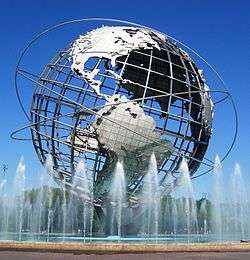Sunnyside, Queens
Sunnyside is a neighborhood in the western portion of the New York City borough of Queens. It shares borders with Hunters Point and Long Island City to the west, Astoria to the north, Woodside to the east and Maspeth to the south. It contains the Sunnyside Gardens Historic District, one of the first planned communities in the United States.[2]
Sunnyside | |
|---|---|
Neighborhood of Queens | |
The gantry over 46th Street at Queens Boulevard is located in the heart of Sunnyside | |
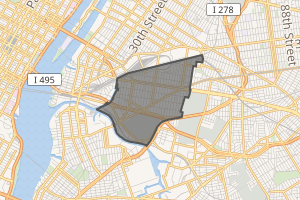
Location within New York City | |
| Country | |
| State | |
| City | |
| County/Borough | |
| Community District | Queens 2[1] |
| Named for | Sunnyside Hill Farms |
| Population | |
| • Total | 63,271 |
| Time zone | UTC−5 (EST) |
| • Summer (DST) | UTC−4 (EDT) |
| ZIP Codes | 11101, 11104, 11377 |
| Area codes | 718, 347, 929, and 917 |
| Website | www |
The name "Sunnyside" originates with the Bragaw family, French Huguenots who had purchased the land in 1713 and named their estate "Sunnyside Hill".[3][4] Sunnyside was a rural hamlet mostly consisting of small farms and marshland. It was incorporated into Long Island City in 1870, and developed into a bedroom community after the Queensboro Bridge was completed in 1909. A large portion of the neighborhood is six-story apartment buildings constructed during the 1920s and 1930s.
Sunnyside is located in Queens Community District 2 and its ZIP Codes are 11101, 11104, and 11377.[1] It is patrolled by the New York City Police Department's 108th Precinct.[5] Politically, Sunnyside is represented by the New York City Council's 26th District.[6]
Sunnyside Gardens subsection
Sunnyside Gardens Historic District | |
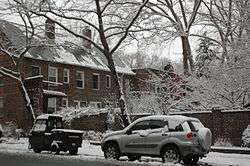 A typical brick row house along 39th Avenue. | |
 Location in New York City  Sunnyside, Queens (New York)  Sunnyside, Queens (the United States) | |
| Location | Roughly bounded by Queens Blvd., 43rd and 52nd Sts. Barnett and Skillman Aves., New York, New York |
|---|---|
| Coordinates | 40°44′49″N 73°55′3″W |
| Area | 53 acres (21 ha) |
| Built | 1924 |
| Architect | Stein, Clarence; Wright, Henry |
| Architectural style | Colonial Revival, Art Deco |
| NRHP reference No. | 84002919 [7] |
| Added to NRHP | September 7, 1984 |
Sunnyside Gardens, listed as a historic district on the National Register of Historic Places,[3][8] is among the first planned communities in the U.S.
Sunnyside Gardens includes one-, two-, and three-family homes, and a few apartment buildings, all made of Hudson brick (it was inexpensive, durable, and available). Each private residence has a small front garden facing the street and a private garden in the rear. The rental units in the two- and three-family houses enjoy private terraces overlooking the gardens. There are two configurations: the courtyard condition and the mews condition; at the edges of the community some homes simply line the street, with a common walkway running the length of the row. Homes in the courtyard blocks enclose an inner courtyard that was designated a common, landscaped but not used for recreation. Each homeowner actually owned, and paid taxes on, the part of the common in the block and lot, even if it was not used. The mews houses face a common front court and back on alleys; each mews house also has a private rear yard.
This model allowed for denser residential development, while also providing ample open/green-space amenities. Clarence Stein and Henry Wright served as the primary architects and planners for this development (Frederick L. Ackerman designed some of the mews houses), and the landscape architect was Marjorie Sewell Cautley.[9][10] As an amenity for the residents, the City Housing Corporation reserved lots on the northern edge of the development (abutting the Sunnyside Yard) for one of only two private parks in the city, the other being Gramercy Park.[11]
Early history
The area was the first development in the United States patterned after the ideas of the garden city movement initiated in England in the first decades of the twentieth century by Ebenezer Howard and Raymond Unwin, specifically Hampstead Garden Suburb and Letchworth Garden City. Covering 77 acres between Queens Boulevard and the Sunnyside Railroad Yards, Sunnyside Gardens was constructed between 1924 and 1928 by the City Housing Corporation, founded by developer Alexander Bing, and architects Clarence Stein and Henry Wright. The project grew out of discussions in the early 1920s about housing and planning; social critic Lewis Mumford and economist Richard T. Ely were leading participants.
In the early years of the Great Depression, nearly 60 percent of the residents lost their homes to foreclosure.[12] Those difficult years saw organized resistance by residents who forcefully resisted efforts by city marshals to evict families. The character of Sunnyside Gardens was protected by 40-year easements which protected the integrity of the courtyards and common walkways and controlled changes to the exterior of every property, extending to even paint color. Those covenants lapsed in the mid-1960s, and some homeowners rushed to claim their property, erecting fences into the middle of some courtyards. In response, in 1974 the Department of City Planning designated Sunnyside Gardens a special planned community preservation district, together with Fresh Meadows, Parkchester, and the Harlem River Houses. With that designation came rules protecting the inner courts and landscaping, and prohibiting driveways and curbcuts, rear sheds, and additions.
Sunnyside Gardens Historic District
The Sunnyside Gardens Historic District is a national historic district that includes 66 contributing buildings and 12 contributing sites.[13] It was listed on the National Register of Historic Places in 1984[7] and as a city historic district in 2007.[14]
Sunnyside Gardens is a park that takes up approximately three and a half acres, also known as a New York City landmark. It was built between 1924 and 1928, roughly taking up 16 blocks, which consists more than 600 buildings. It has 12 courts within the landmark, which are known as Carolin Gardens, Colonial Court, Hamilton Court, Hamilton Court Apartments, Harrison Place, Jefferson Court, Lincoln Court, Madison Court North and South, Monroe Court Apartments, Phipps Garden Apartments I, Phipps Garden Apartments II, Roosevelt Court, Washington Court, and the Wilson Court.[15] Sunnyside Gardens is located in the Northwestern part of Queens which was established by Clarence Stein, Henry Wright and the City Housing Corporation were led by Alexander Bing.[16] The creators of the Sunnyside Gardens wanted to create housing which would be inexpensive to residents to stop the shortages and overcrowding of other areas.
In 2003, a grassroots movement started to request designation as a New York City Historic District, in response to lack of protection for the historic character of the homes in the neighborhood. The campaign was contentious and garnered publicity in major news outlets, including WNYC and the New York Times. On April 17, 2007, the New York City Landmarks Preservation Commission (NYCLPC) held a public hearing on the neighborhood, which was controversial, with 60 people speaking in favor and 25 against the designation.[17] This was documented on New York Public Radio in a segment called "Cloud Over Sunnyside?".[18] On June 26, 2007, the NYCLPC voted to designate the community.[14] The designation prevents most major work from being done without consultation with the NYCLPC.
Demographics
Based on data from the 2010 United States Census, the population of Sunnyside was 63,271, a change of 1,324 (2.1%) from the 61,947 counted in 2000. Covering an area of 2,340.44 acres (947.14 ha), the neighborhood had a population density of 27 inhabitants per acre (17,000/sq mi; 6,700/km2).[19]
The racial makeup of the neighborhood was 35.4% (22,424) White, 2.5% (1,588) African American, 0.2% (109) Native American, 24.3% (15,390) Asian, 0%(29) Pacific Islander, 0.6% (395) from other races, and 2.1% (1,342) from two or more races. Hispanic or Latino of any race were 34.8% (21,994) of the population.[20]
The entirety of Community Board 2, which comprises Sunnyside and Woodside, had 135,972 inhabitants as of NYC Health's 2018 Community Health Profile, with an average life expectancy of 85.4 years.[21]:2, 20 This is higher than the median life expectancy of 81.2 for all New York City neighborhoods.[22]:53 (PDF p. 84)[23] Most inhabitants are middle-aged adults and youth: 17% are between the ages of 0–17, 39% between 25–44, and 24% between 45–64. The ratio of college-aged and elderly residents was lower, at 8% and 12% respectively.[21]:2
As of 2017, the median household income in Community Board 2 was $67,359.[24] In 2018, an estimated 20% of Sunnyside and Woodside residents lived in poverty, compared to 19% in all of Queens and 20% in all of New York City. One in twenty residents (5%) were unemployed, compared to 8% in Queens and 9% in New York City. Rent burden, or the percentage of residents who have difficulty paying their rent, is 51% in Sunnyside and Woodside, about equal to the boroughwide and citywide rates of 53% and 51% respectively. Based on this calculation, as of 2018, Sunnyside and Woodside is considered to be high-income relative to the rest of the city and not gentrifying.[21]:7
Queens is one of the most ethnically diverse urban areas in the world.[25] Sunnyside's residents are also ethnically diverse and include people of Albanian, Algerian, Argentine, Armenian, Bangladeshi, Bosnian, Bulgarian, Burmese, Chinese, Colombian, Dominican, Ecuadorian, Egyptian, Filipino, French, German, Greek, Hungarian, Indian, Iraqi, Irish, Israeli, Italian, Japanese, Korean, Lebanese, Mexican, Moroccan, Nepali, Pakistani, Paraguayan, Peruvian, Polish, Puerto Rican, Romanian, Russian, Salvadoran, Thai, Tibetan, Tunisian, Turkish, Ukrainian, Vietnamese and Yemeni ancestry. Sunnyside has a variety of ethnic cuisine, which is showcased during an annual springtime food festival called Taste of Sunnyside where people can sample cuisines from local restaurants.[26]
Police and crime
Woodside, Sunnyside, and Long Island City are patrolled by the 108th Precinct of the NYPD, located at 5-47 50th Avenue.[5] The 108th Precinct ranked 25th safest out of 69 patrol areas for per-capita crime in 2010.[27] With a non-fatal assault rate of 19 per 100,000 people, Sunnyside and Woodside's rate of violent crimes per capita is less than that of the city as a whole. The incarceration rate of 63 per 100,000 people is lower than that of the city as a whole.[21]:8
The 108th Precinct has a lower crime rate than in the 1990s, with crimes across all categories having decreased by 88.2% between 1990 and 2018. The precinct reported 2 murders, 12 rapes, 90 robberies, 108 felony assaults, 109 burglaries, 490 grand larcenies, and 114 grand larcenies auto in 2018.[28]
Fire safety
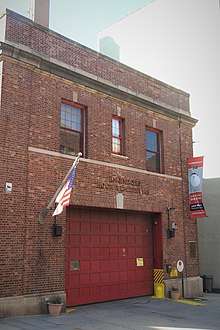
Sunnyside is served by the following New York City Fire Department (FDNY) fire stations:[29]
Health
Preterm births are more common in Sunnyside and Woodside than in other places citywide, but teenage births are less common. In Sunnyside and Woodside, there were 90 preterm births per 1,000 live births (compared to 87 per 1,000 citywide), and 14.9 teenage births per 1,000 live births (compared to 19.3 per 1,000 citywide).[21]:11 Sunnyside and Woodside has a high population of residents who are uninsured. In 2018, this population of uninsured residents was estimated to be 16%, which is higher than the citywide rate of 12%.[21]:14
The concentration of fine particulate matter, the deadliest type of air pollutant, in Sunnyside and Woodside is 0.0093 milligrams per cubic metre (9.3×10−9 oz/cu ft), higher than the city average.[21]:9 Fourteen percent of Sunnyside and Woodside residents are smokers, which is equal to the city average of 14% of residents being smokers.[21]:13 In Sunnyside and Woodside, 20% of residents are obese, 9% are diabetic, and 23% have high blood pressure—compared to the citywide averages of 20%, 14%, and 24% respectively.[21]:16 In addition, 19% of children are obese, compared to the citywide average of 20%.[21]:12
Ninety-two percent of residents eat some fruits and vegetables every day, which is higher than the city's average of 87%. In 2018, 79% of residents described their health as "good," "very good," or "excellent," slightly higher than the city's average of 78%.[21]:13 For every supermarket in Sunnyside and Woodside, there are 17 bodegas.[21]:10
The nearest large hospitals in the area are the Elmhurst Hospital Center in Elmhurst and the Mount Sinai Hospital of Queens in Astoria.[32]
Post office and ZIP Codes
Sunnyside is covered by three ZIP Codes. The area west of 39th Street is covered by 11101, while Sunnyside Gardens is located in 11104, and the area east of 45th Street is inside 11377.[33] The United States Post Office operates the Sunnyside Station at 45-15 44th Street.[34]
Education
Sunnyside and Woodside generally has a slightly higher ratio of college-educated residents than the rest of the city. While 45% of residents age 25 and older have a college education or higher, 19% have less than a high school education and 35% are high school graduates or have some college education. By contrast, 39% of Queens residents and 43% of city residents have a college education or higher.[21]:6 The percentage of Sunnyside and Woodside students excelling in math rose from 40% in 2000 to 65% in 2011, and reading achievement rose from 45% to 49% during the same time period.[35]
Sunnyside and Woodside's rate of elementary school student absenteeism is less than the rest of New York City. In Sunnyside and Woodside, 11% of elementary school students missed twenty or more days per school year, lower than the citywide average of 20%.[22]:24 (PDF p. 55)[21]:6 Additionally, 86% of high school students in Sunnyside and Woodside graduate on time, more than the citywide average of 75%.[21]:6
Schools
Sunnyside contains the following public schools:[36]
- PS 150 Sunnyside (grades PK-6)[37]
- PS 199 Maurice A Fitzgerald (grades PK-5)[38]
- IS 125 Thomas J McCann Woodside (grades 6-8)[39]
- Robert F Wagner Junior Secondary School-Arts and Technology (grades 6-12)
- Academy of Finance and Enterprise (grades 9-12)
- Aviation Career and Technical High School (grades 9-12)
- Queens Vocational and Technical High School (grades 9-12)
Library
The Queens Public Library's Sunnyside branch is located at 43-06 Greenpoint Avenue.[40]
Community organizations
- Sunnyside Community Services - 43-31 39th Street
- Sunnyside Chamber of Commerce
Parks and recreation
Parks in the area include:
- L/Cpl. Thomas P. Noonan Playground, located between Greenpoint Avenue, 42nd Avenue, 43rd Street, and 47th Streets. The park was acquired in 1936 and commemorates Thomas P. Noonan Jr., a local resident who was killed in an ambush during the Vietnam War and posthumously honored.[41]
- Torsney Playground, located at Skillman Avenue and 43rd Street. It was built in the 1950s and honors George F. Torsney, a local politician and World War I veteran.[42]
- Sabba Park, located in the median of Queens Boulevard between 48th Street and 49th Street. It honors Joe Sabba, a World War II veteran, and was founded in 1913.[43]
Transportation
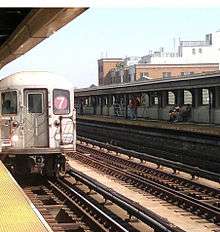
Sunnyside is served by the 7 train on the New York City Subway's IRT Flushing Line, with 33rd Street–Rawson Street, 40th Street–Lowery Street, and 46th Street–Bliss Street in Sunnyside. The Q32, Q39, Q60, Q104, B24 buses run through Sunnyside.
The area is connected to Manhattan via the Long Island Expressway and the Queens Midtown Tunnel and to Brooklyn via the Brooklyn-Queens Expressway.
Sunnyside is also known for the former Pennsylvania Railroad (now Amtrak) railyard known as Sunnyside Yard. It is a staging area for both Amtrak and New Jersey Transit trains leaving from Penn Station. The proposed East Side Access project will include a new Long Island Rail Road train station in Sunnyside at Queens Boulevard along the LIRR's Main Line (into Penn Station) will provide one-stop access for area residents to Midtown Manhattan and Grand Central Terminal.[44]
Notable people

Notable celebrities include Johanna Magdalena Beyer, Perry Como, Nancy Walker, Benh Zeitlin, David Horowitz, Peter Szabaga, Judy Holliday,[45] Joe Spinell, James Caan and Rudy Vallee;[46] artist Raphael Soyer, and writers and social activists such as Lewis Mumford and Suze Rotolo. William Patrick Stuart-Houston, the nephew of Adolf Hitler, lived in Sunnyside for a brief period of time before leaving for the U.S. Navy in 1944. Former pro wrestler Chris Kanyon came from Sunnyside, as did New York City police commissioner Dermot F. Shea.
Additionally, several other people have been involved with Sunnyside's history. The Queens-grown punk rock group The Ramones played some of their earliest gigs in Sunnyside pubs during the 1970s. In the years before World War II New York Giants star Hap Moran coached a youth football team, the Mustangs, in Sunnyside Park.[47] Legendary jazz musician Bix Beiderbecke died at 43–30 46th Street in Sunnyside, and a plaque was erected in his honor by the Greater Astoria Historical Society.[48]
In popular culture
Notable films shot in the area include:
- The Believer
- The Opportunists
- Queen of Media
- Raising Helen
- Sleepers
- Spider-Man (some exterior scenes)
- Spider-Man: Homecoming
Several television shows have shot scenes in the neighborhood, including:
- Blue Bloods
- Gotham
- Person of Interest
- Unforgettable
- White Collar
- Sunnyside
See also
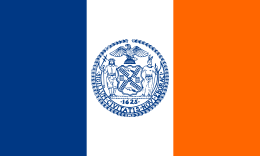
References
- "NYC Planning | Community Profiles". communityprofiles.planning.nyc.gov. New York City Department of City Planning. Retrieved April 7, 2018.
- Haller, Vera (March 18, 2015). "Sunnyside, Queens, 'Mayberry' Near Midtown". The New York Times. ISSN 0362-4331. Retrieved October 25, 2017.
- "Sunnyside" on Forgotten NY Neighborhoods
- Wilkinson, Christina (September 12, 2005). "Sunnyside, Queens". Forgotten New York.
- "NYPD–108th Precinct". www.nyc.gov. New York City Police Department. Retrieved October 3, 2016.
- Current City Council Districts for Queens County, New York City. Accessed May 5, 2017.
- "National Register Information System". National Register of Historic Places. National Park Service. March 13, 2009.
- Vitullo-Martin, Julia (July 7, 2005). "A Pioneering Queens Garden Community Flourishes Anew". New York Sun. Retrieved January 17, 2010.
- Community and Library History, Queens Public Library. Accessed February 14, 2008.
-
- "Sunnyside" on Forgotten NY
- Vitullo-Martin, Julia. "A Pioneering Queens Garden Community Flourishes Anew" New York Sun (July 7, 2005)
- Konigsberg, Eric (June 19, 2008). "The Guardian of Gramercy Park". New York Times. Retrieved December 7, 2014.
Gramercy is one of two private parks in New York City (the other, in Queens, is Sunnyside Gardens Park) and a key is required not only to enter, but to leave through a gate in its wraparound wrought-iron fence.
- Kroessler, Jeffrey A., Building Queens: the urbanization of New York's largest borough. Ph.D. dissertation, CUNY Graduate School, 1991.
- Merrill Hesch (August 1984). "National Register of Historic Places Registration: Sunnyside Gardens Historic District". New York State Office of Parks, Recreation and Historic Preservation. Retrieved January 16, 2011. See also: "Accompanying 24 photos".
- "Sunnyside Gardens Designation Report" (PDF). New York City Landmarks Preservation Commission. June 26, 2007. Retrieved November 10, 2019.
- "History". Sunnyside Gardens. Retrieved May 18, 2017.
- kkirvin. "SUNNYSIDE GARDENS, Borough of Queens Sunnyside Gardens, in northwestern Queens, was the creation of architects Clarence Stein an" (PDF). webcache.googleusercontent.com. Archived from the original (PDF) on February 12, 2017. Retrieved May 18, 2017.
- Barry, Ellen (July 5, 2007). "A Pocket of Queens Brimming With History, and Now Resentment". The New York Times. Retrieved January 17, 2010.
- "Cloud over Sunnyside?". WNYC. Retrieved April 24, 2016.
- Table PL-P5 NTA: Total Population and Persons Per Acre - New York City Neighborhood Tabulation Areas*, 2010, Population Division - New York City Department of City Planning, February 2012. Accessed June 16, 2016.
- Table PL-P3A NTA: Total Population by Mutually Exclusive Race and Hispanic Origin - New York City Neighborhood Tabulation Areas*, 2010, Population Division - New York City Department of City Planning, March 29, 2011. Accessed June 14, 2016.
- "Woodside and Sunnyside (Including Blissville, Hunters Point, Long Island City, Sunnyside, Sunnyside Gardens and Woodside)" (PDF). nyc.gov. NYC Health. 2018. Retrieved March 2, 2019.
- "2016-2018 Community Health Assessment and Community Health Improvement Plan: Take Care New York 2020" (PDF). nyc.gov. New York City Department of Health and Mental Hygiene. 2016. Retrieved September 8, 2017.
- "New Yorkers are living longer, happier and healthier lives". New York Post. June 4, 2017. Retrieved March 1, 2019.
- "NYC-Queens Community District 2--Sunnyside & Woodside PUMA, NY". Census Reporter. Retrieved July 17, 2018.
- Colangelo, Lisa L. (July 12, 2009). "Queens one of 'most diverse places on Earth,' new figures show". New York Daily News. Retrieved August 1, 2018.
- http://www.sunnysideshines.org/taste-sunnyside
- "Sunnyside and Woodside–DNAinfo.com Crime and Safety Report". www.dnainfo.com. Archived from the original on April 15, 2017. Retrieved October 6, 2016.
- "108th Precinct CompStat Report" (PDF). www.nyc.gov. New York City Police Department. Retrieved July 22, 2018.
- "FDNY Firehouse Listing – Location of Firehouses and companies". NYC Open Data; Socrata. New York City Fire Department. September 10, 2018. Retrieved March 14, 2019.
- "Engine Company 325/Ladder Company 163". FDNYtrucks.com. Retrieved March 7, 2019.
- "Engine Company 259/Ladder Company 128/Battalion 45". FDNYtrucks.com. Retrieved March 7, 2019.
- Finkel, Beth (February 27, 2014). "Guide To Queens Hospitals". Queens Tribune. Archived from the original on February 4, 2017. Retrieved March 7, 2019.
- "Sunny Side, New York City-Queens, New York Zip Code Boundary Map (NY)". United States Zip Code Boundary Map (USA). Retrieved March 9, 2019.
- "Location Details: Sside". USPS.com. Retrieved March 7, 2019.
- "Woodside and Sunnyside–QN 02" (PDF). Furman Center for Real Estate and Urban Policy. 2011. Retrieved October 5, 2016.
- "Sunnyside New York School Ratings and Reviews". Zillow. Retrieved March 9, 2019.
- "P.S. 150 Queens". New York City Department of Education. December 19, 2018. Retrieved March 9, 2019.
- "P.S. 199 Maurice A. Fitzgerald". New York City Department of Education. December 19, 2018. Retrieved March 9, 2019.
- "I.S. 125 Thom J. McCann Woodside". New York City Department of Education. December 19, 2018. Retrieved March 9, 2019.
- "Branch Detailed Info: Sunnyside". Queens Public Library. Retrieved March 7, 2019.
- "L/CPL Thomas P. Noonan Jr. Playground Highlights : NYC Parks". New York City Department of Parks & Recreation. June 26, 1939. Retrieved March 9, 2019.
- "Torsney Playground Highlights : NYC Parks". New York City Department of Parks & Recreation. June 26, 1939. Retrieved March 9, 2019.
- "Sabba Park Highlights : NYC Parks". New York City Department of Parks & Recreation. June 26, 1939. Retrieved March 9, 2019.
- Vandam, Jeff. "An Enclave at Once Snug and Inclusive", The New York Times, February 4, 2007. Accessed February 14, 2008. "When the Long Island Rail Road's East Side Access project is completed in 2013, its trains, too, will go to Grand Central. Sunnyside's new station in the system will create a nonstop commute to Midtown."
- Shepard, Richard F. "Memories of My Queens", The New York Times, September 3, 1995. Accessed October 19, 2007. "My earliest memories are of Sunnyside, about 1929 and 1930, when my family moved to Queens and bought a house in Sunnyside Gardens, on what was then called Locust Street. Our next-door neighbors were a family by the name of Tuvim, whose daughter was to become a star of Broadway and Hollywood named Judy Holliday, although as a younger-than-teen-age Queens girl she gave little evidence of such talent."
- "Spare Times", The New York Times, October 12, 2001. Accessed October 19, 2007. "Hometown NYC: Sunnyside, Queens. A tour of the area that was once home to Rudy Vallee, led by Saul Bennett, a poet who was raised in the neighborhood."
- "Hap Moran". Retrieved April 24, 2016.
- "Solo in Sunnyside; Frank Gray travels through Queens, New York, in search of the late Bix Beiderbecke." The Guardian, April 30, 2005.
External links
| Wikimedia Commons has media related to Sunnyside, Queens. |
- Sunnyside Chamber of Commerce
- New York Metro: 6 Affordable Neighborhoods – Sunnyside
- NYTimes: An Enclave at Once Snug and Inclusive
- Greater Astoria Historical Society
- Sunnyside Post, local news site for Sunnyside residents
- Sunnyside Neighborhood on Queens Buzz
Sunnyside Gardens
